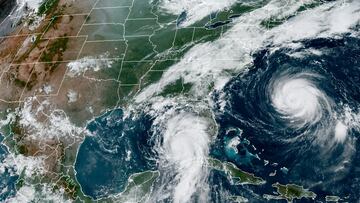What happens when two hurricanes collide? The Fujiwhara Effect explained
Two hurricanes are churning in the Atlantic Basin prompting the question of what happens if they collide with each other. The Fujiwhara Effect explains…

Hurricane Idalia has begun its march north threatening to slam into the Gulf Coast of Florida, forecast for some time Wednesday morning, possibly as a Category 3 hurricane. At the same time, another tempest is churning in the Atlantic, Category 4 Hurricane Franklin, heading northeast toward Bermuda.
Having two hurricanes in such relative proximity has raised the question of what would happen should the two collide. That scenario is unlikely to happen, while Idalia’s path is forecast to take it towards Bermuda after crossing Florida, Franklin is predicted to be long gone. However, such a scenario has been studied and is known as the Fujiwhara Effect.
You may be interested in: How are hurricanes named and why do the names get retired?
What happens when two hurricanes collide? The Fujiwhara Effect explained
The existence of more than one tropical storm or hurricane at the same time happens with frequency. Recently, the Atlantic Basin saw a burst of activity with four tropical depressions becoming named storms in a span of 39 hours. That was a record for the most in the shortest time span.
However, two storms colliding is a relatively rare occurrence, but what happens was described in 1921 by Sakuhei Fujiwhara, a Japanese meteorologist from whom the effect gets its namesake. Basically, when the two tropical cyclones come within 870 miles of each other, they begin a sort of dance around their common center.
Getting lots of questions: What happens if 2 storms run into each other? Its known as the Fujiwara effect. The larger system absorbs the smaller one. It happened last in 2017 in the Pacific. Hurricane Hilary absorbed TS Irwin. pic.twitter.com/mkuH0B3W7n
— Phil Ferro (@PhilFerro7) August 21, 2020
There are a few potential outcomes from their interaction as the National Weather Service explains. If one tropical cyclone is much stronger than the other, the weaker one will orbit the larger hurricane and eventually be absorbed. This happened most recently in 2017 when Hurricane Hilary and Hurricane Irwin approached each other in the Pacific.
Related stories
On the other hand, if the two are of relatively similar strength, they could gravitate towards one another and either reach a common point and merge into one or they will do their ditty for a while before going off on their own paths. The latter happened in 1995 when Iris and Humberto got close to each other. Iris was slightly weaker and the interaction weakened it further but the two went their separate paths. However, Iris built up strength again and went on to swallow Tropical Storm Karen.
Finally, in rare occasions, when the two hurricanes come together there is an additive effect that results in a larger single storm.

